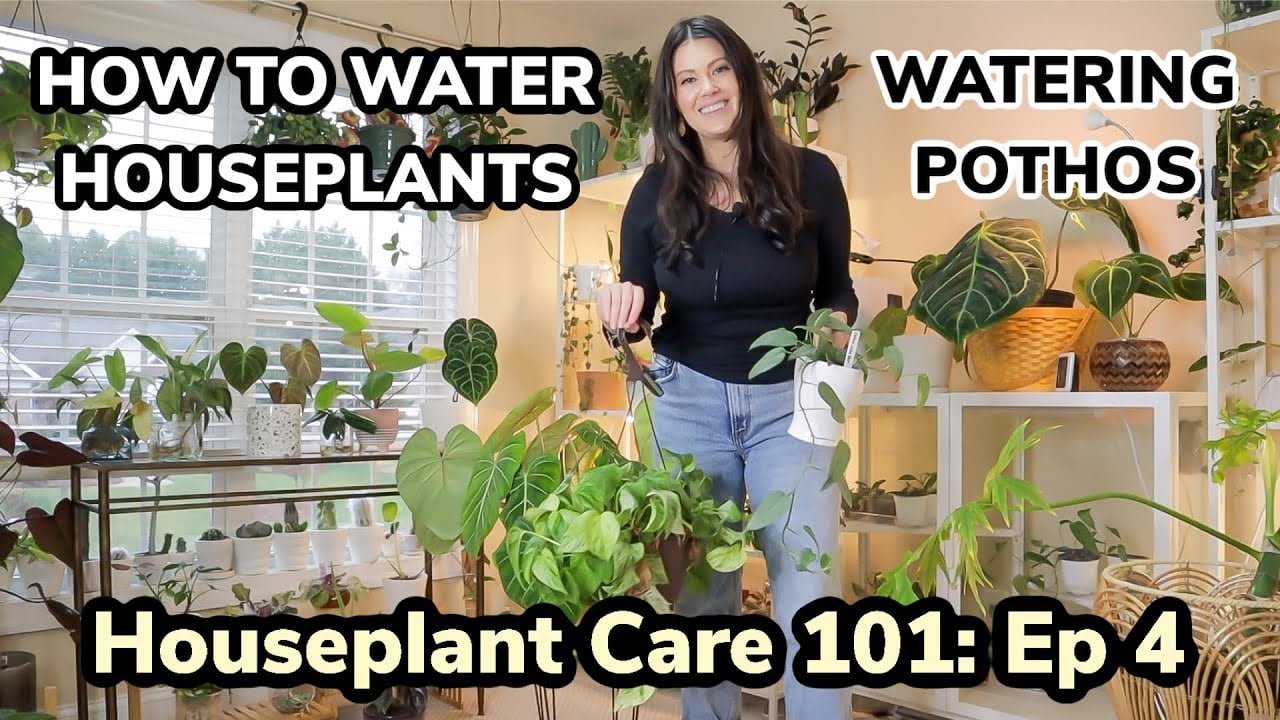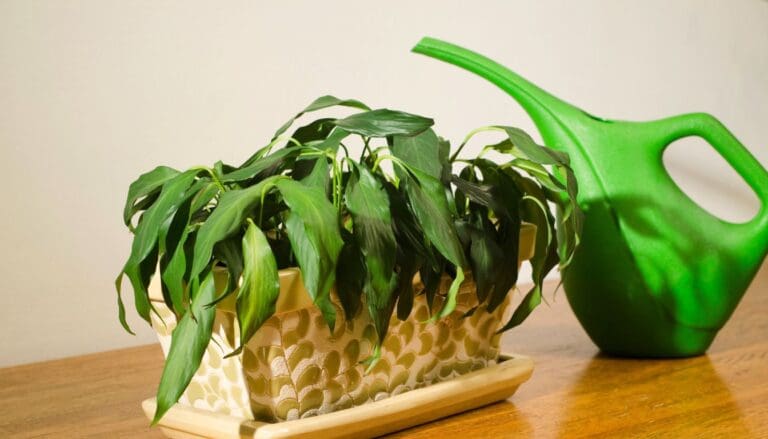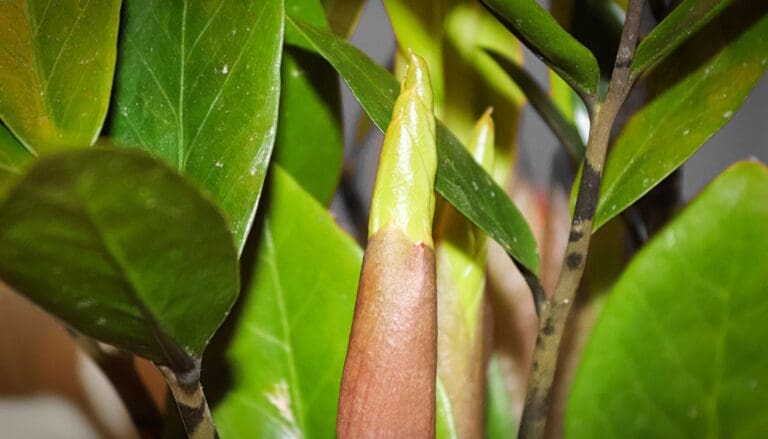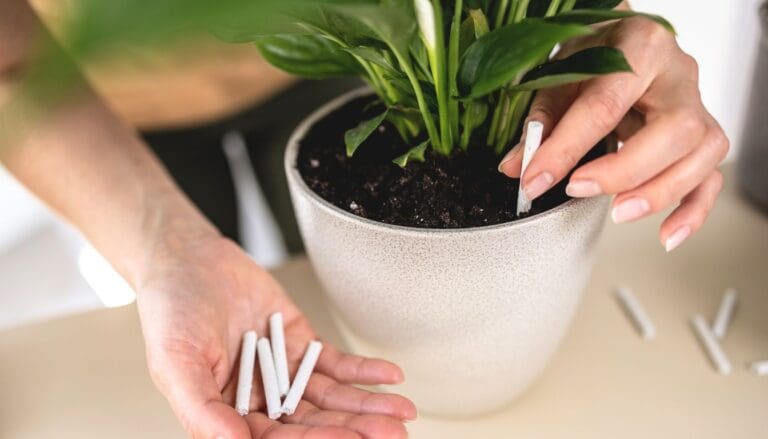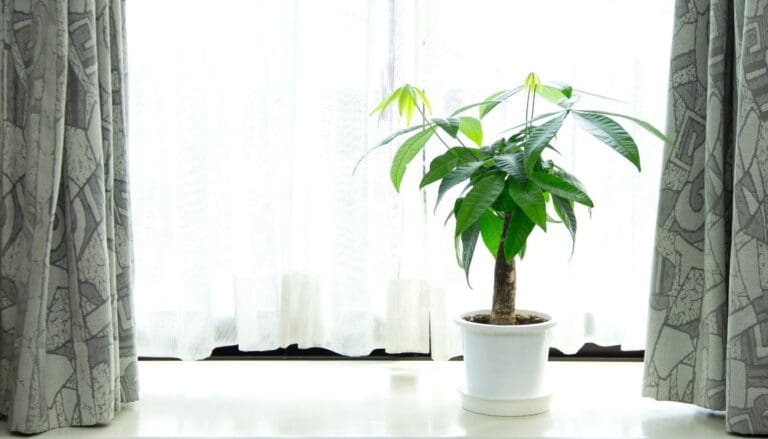How Often To Water Pothos? (How To, How Much & More)
Have you ever wondered how often you should water your pothos plant and how much water it needs? In this blog, we will discuss the best watering practices for pothos plants and provide some helpful tips.
Typically, water your Pothos once a week or every 5 to 7 days, allowing the 2-3 inches of the topsoil to dry. However, this frequency depends on seasons, light, humidity, soil, pot, and plant maturity.
Are you new to growing Pothos? This guide covers everything you need, exploring each factor related to Pothos watering. By the end, you’ll have a clear understanding of it.

Please note: Simplify Plants is reader-supported. Some links in the post are affiliate links and I get a commission from purchases made through links in the post.
Basic watering requirements and frequency for Pothos plant
Originating from Southeast Asia, Pothos plants are common houseplants.
They are easy to grow, and low maintenance and their heart-shaped leaves can brighten up any corner of the house.
Pothos are quite easy-going plants. A bit of extra or less moisture will not throw them off the track.
But going overboard is something you should not do.
Pothos like high humidity, but despite this fact, Pothos like a bit of dry spell, but not for too long.
Usually, Pothos enjoys growing in soil that is neither too wet nor too dry.
The best is to check the moisture level regularly and water the plant whenever ⅓rd of the soil has dried, not the entire soil.
It’s generally fine to water the Pothos plant every 5 to 7 days.
If needed, you can extend the gap to 7 to 14 days.
Now, several factors can affect the watering needs and frequency of the Pothos plant.
Let’s move to the next section to understand these factors in detail.
Factors affecting the watering needs of Pothos plant
Generally, you can water the plant every 5-7 days, but it will depend on various factors.
These factors can affect the general watering frequency of Pothos plants.
That’s why checking the moisture level before watering is always recommended.
Following this method for prolonged periods will give you an idea about your plant’s watering needs.
Then, you can make a watering schedule of your own.
Let’s see how these factors affect the watering frequency of Pothos:
Time of the year or seasonal variations
The very first and essential factor to consider is the season.
Watering frequency changes according to the season because with a season change, the temperature, light level, humidity, and every other environmental factor.
Watering Pothos in the spring
Spring is the time when the temperature starts rising after a long winter.
However, the plant may not start its active growth as soon as spring arrives. It will take time.
Pothos might start its growth in May, usually the last month of spring.
You can water the plant every 7 to 10 days.
But you must check the moisture level.
Since the plant will not start growing immediately, you might have to water it less frequently based on your plant’s behavior.
Pothos summer watering
The summer season is a period of growth for the Pothos plant.
The sun’s intensity and temperature are relatively higher than usual.
The plant begins to thrive, and its demand for moisture and nutrients increases.
Warm weather with bright sunlight makes the Pothos plant thirsty because moisture dries out faster, and some evaporates.
Therefore, you must water the Pothos plant 1-2 times weekly.
Remember to check the moisture level before watering.
The top few inches must stay dry before watering.
Watering Pothos in the Fall
As fall arrives, the temperature will begin to reduce, and the plant will also start slowing down its growth.
It hasn’t yet stopped its growth; it will grow slowly.
During the fall, you can water the Pothos plant every 7 to 14 days.
The temperature changes and gets cooler in the fall, but it happens more gradually.
So, try to keep up with watering and don’t stop it. Check the moisture level before watering.
Pothos winter watering
During the winter, Pothos go dormant.
In this condition, the plant reduces its growth and doesn’t absorb any moisture and nutrients as usual.
It happens once the indoor temperature goes below 55°F.
Besides that, the sunlight level and intensity also reduce during the winter.
The soil takes too much time to absorb the moisture from the soil.
So, the watering frequency will be much less compared to the summers.
I suggest a bi-weekly watering or every 10-14 days.
Do check the soil before watering.
Pothos like to dry out between each watering session, whatever the season.
Plant size and maturity
Mature plants and rooted cuttings will have different watering needs.
The young plants have small roots.
Though they grow best with the correct moisture level, their roots will absorb less water.
On the other hand, mature plants have a good root system, can absorb moisture from the soil, and need frequent watering at least once a week.
Here’s what I have learned while growing Pothos:
- 12-inch Pothos or less: Once every 2-3 weeks.
- 2-3 feet: Once a week.
- Pothos over 5 feet: 1-2 times per week.
Also read: How fast do pothos grow?
Light conditions

Pothos plants do best under moderate or indirect sunlight.
If the plant receives more light, soil dries out faster due to increased evaporation.
In that case, you need to water them more often, 1-2 times weekly.
Pothos can tolerate low light to some extent, but they hate shade.
If your Pothos stay under lowlights, they take time to dry out.
In that case, you need to water the plant much less, for example, every 7 to 10 days.
Also read: Pothos plant light requirement.
Temperature range of the rooms
Watering frequency will change based on the temperature of your room.
In summer, if indoor temperatures exceed 80°F, your Pothos will need more frequent watering.
On the contrary, when the temperature goes below 55-60°F indoors in the winter, reduce the watering frequency for your Pothos plant.
You can follow the schedule I shared in the “Season” point.
Soil type and quality considerations
The next important factor is the soil type.
Pothos enjoy growing in well-drained, loose soil rich in organic matter.
Well-drained soil drains water properly.
So, Pothos need to be watered more frequently.
On the other hand, if the soil is slow in drainage, you have to reduce the watering frequency.
If the soil doesn’t drain well, replacing it and using well-drained, well-aerated, and well-retained soil is better.
Soil with poor drainage increases the risk of overwatering and root rot. So, it is better to avoid heavy soil mixes.
Pot considerations
The pot size and quality also affect the watering frequency.
A small pot can carry less amount of soil.
Therefore, the amount of water it can hold will be less.
If the amount of moisture is insufficient for the Pothos plant, you might have to water the plant more often.
On the other hand, a bigger pot can hold more soil with sufficient moisture.
In that case, you can water the Pothos plant less often.
Don’t use a huge pot.
Another thing to consider is the potting material.
Ceramic, earthenware, and terracotta pots are made of porous materials.
Therefore, they wick away moisture quickly, prompting more frequent watering.
In contrast, plastic or glazed pots don’t allow the water to evaporate or dry faster, can hold moisture for long, and need less frequent watering.
You can use self-watering pots.
Please fill the reservoir occasionally; the plant will absorb the required moisture without watering issues.
Make sure that the pot has drainage holes.
Humidity levels
High humidity levels mean more moisture in the air, leading to a longer time for the soil to dry out.
But with low humidity levels, the air remains dry, and soil dries faster.
In that case, it will need frequent watering.
In this case, I suggest you adjust the humidity besides the watering habits.
If the humidity seems too high, along with reducing watering, try to adjust it by installing dehumidifiers and increasing airflow around the Pothos plant.
You can also turn on the AC for some time to increase the airflow.
It will allow the plant to breathe.
If the humidity is low, you can install humidifiers, mist your Pothos, use a pebble tray method, or consider group planting.
Signs of water imbalance: Overwatering vs. Underwatering

As a beginner, it is common to make some mistakes while watering.
Two common issues are overwatering and underwatering. Let’s discuss a bit about them:
Overwatering
Overwatering happens when you water without letting the soil dry out properly.
When watering the Pothos plant, allow the top 2-4 inches to dry out before watering.
Watering without letting the soil dry out will increase moisture levels, reduce oxygen, suffocate the roots, and hinder moisture and nutrient uptake.
Over time, wet conditions attract pests, mold, and fungi, causing root rot.
The common signs of overwatering are:
- Brown spots on the leaves
- Black leaves and stems
- Yellow or brown leaves.
- Mushy and shriveled leaves
- Mold growing on the soil surface
- Foul smell, indicating root rot
If you have overwatered, stop watering immediately and quit following any routine.
Allow the soil to dry out before you water next. However, please don’t keep it dry for too long.
Provide the plant with good sunlight and ventilation to aid in drying.
Keep checking the soil moisture and start watering only when the top few inches have dried.
After a few weeks, you will notice new growth and your plant will again look healthy.
If there’s a root rot, remove the plant from the pot, cut off damaged roots, spray fungicides, and repot your plant.
Underwatering
The problem stresses the Pothos plant, but the impact is less than overwatering.
Without enough moisture, the plant and roots stay dehydrated, and the plant loses its ability to absorb moisture and nutrients.
The Pothos plant may enjoy some dryness for some time, but not too long.
Common underwatering signs in Pothos are:
- Wilted leaves
- Dry and yellow or brown leaves
- Dead leaf tips
- Curly and brittle leaves
- Droopy stems and vines
If you see these signs, check the soil once.
If it feels too dry, start watering the plant until the excess comes from the drainage holes.
Another option is to try bottom watering, provided the soil has become extremely dry.
After a few weeks, your plant should perk up and produce new leaves.
If these don’t work, you might have to replace the soil.
Understanding when Pothos plants need water
It is challenging for a beginner to understand when Pothos need water and end up with a water imbalance.
Some gardeners allow the entire soil to dry out, keep it like that for some days, and water the plant when it shows signs like dry leaves and wilting.
They do this most of the time.
Inconsistent watering will stress the plant, leading to issues like yellowing, browning, stunted growth, and defoliation.
Consistency is the primary key.
I always suggest checking the moisture level once a week.
Except for that, there are a few more ways to check when Pothos need water:
- Stick your index finger into the soil about 2-3 inches deep. If it feels moist, wait for a few more days. Recheck it. If it feels dry, water the plant.
- You can use a stick instead of your finger. The method is similar to the finger test. While taking out the stick, check if the soil sticks to it. Wait for a few days. Water the plant only when the stick remains dry and no soil clings to it.
- You can use a moisture meter. Insert the probe into the soil. Your plant is ready to absorb water when the result is between 1 and 3.
- Pick up the plant and feel the weight. If it’s light, it’s time to water the plant. If it feels heavy, wait for some more days.
Pothos watering techniques: How to water?
The best way to water the Pothos plant is using the soak-and-drain method.
Here, you will continue watering the Pothos plant deeply until you watch the excess water draining from the potholes.
It will saturate the entire soil with the roots well and provide good hydration for several days.
Deep watering will keep the plant well-hydrated, and you don’t have to worry about watering for at least 4-5 days.
This method also helps in flushing off the excess fertilizer salts and preventing fertilizer burns.
Here’s a quick guide about how to water the Pothos plant:
- You can take the Pothos pot off the drip tray and put it in a sink or bathtub.
- Slowly pour water on the soil surface near the plant base with a watering can or a jug.
- Keep pouring water for some minutes until the excess water drips out of the drainage holes from the pot’s bottom.
- Allow the excess to drain for 10-15 minutes before placing it back on the drip tray.
You can also use a shower head for the soak-and-drain method.
This alternative will also help you dislodge and remove pests and wash dust from the leaves.
Bottom watering vs. Top watering
There is quite a debate about whether bottom watering or top watering will be best for the Pothos plant.
Generally, both are ideal if done with the correct methods.
Top watering is easy compared to bottom water.
Take a jug or watering can and continue pouring the water on the soil surface until you see the excess draining out of the potholes.
This is very helpful as it can flush off the salts accumulated from fertilizers and tap water (if used) and prevent harsh mineral buildup and fertilizer burns.
Bottom watering can be beneficial if the plant’s soil has become extremely dry and hydrophobic.
When the soil becomes too dry, it repels water and doesn’t seep through the soil.
The water remains stagnant on the surface.
In bottom watering, when you sink it in a container filled with water for some minutes, the soil will absorb the moisture efficiently through the drainage holes.
Another method is to sink the pot up to the plant’s stem close to the base for a few minutes.
If bubbles are seen, it means that the soil is absorbing water.
Both methods are advantageous in different situations.
Special considerations while watering the Pothos plant
Now that you know when and how often to water the Pothos plant, there are a few special considerations to look at.
Once you understand the Pothos plant’s watering needs, following the instructions with the following tips will make you a watering expert.
Let’s have a look at these tips:
- Drainage is the most important thing when you are watering the Pothos plant. An ideal soil mix is 4 parts perlite, 3 parts coco coir, 2 parts orchid bark, and 1 part vermicompost. Make sure the pot has drainage holes.
- Always check the soil moisture before watering and allow the top few inches of the soil to dry out before watering.
- Do not follow any strict schedule from the start. Check the moisture level, understand how your plant absorbs in different situations, and then make a routine based on your experiment and experience.
- It’s not the amount of water that causes overwatering but the watering frequency. So, when watering, provide sufficient water and stop it when excess drains out.
- Always use room temperature water, neither too hot nor too cold.
- Maintain consistency in watering the Pothos plant.
- Use a combination of top and bottom watering for better results.
Final thoughts
Generally, you can water the Pothos every 5-7 days. You can extend it to a maximum of every 7-14 days. However, several factors will determine how often to water Pothos, such as season, light conditions, room temperature, humidity, soil and pot type, and plant maturity.
You must be careful about these factors, understand the soil’s moisture level and your plant’s behavior, and then water the plant. The best method is to check the moisture level weekly and then water the plant whenever the top few inches have dried.
You can go for both top and bottom watering for the best results. If you have overwatered or underwatered your plant, take immediate action to fix the issue, as I have explained. Follow the special tips I have shared to excel in watering the Pothos plant and keep it healthy in the long run.
How much water do Pothos need?
Generally, give 1-2 cups to young plants and 3-4 cups to mature plants. Provide sufficient water until excess drains.
What type of water is ideal for Pothos?
Tap water is suitable unless it’s hard; let it sit for 24 hours to dissipate the harsh minerals. Rainwater and distilled water are better alternatives.
Reference: Pothos Wikipedia
Recommended Garden Supplies
| Product Image | Our Recommended Gardening Supplies | Check Offers! |
|---|---|---|
Top Top
Top
Top
Top
Top
Top
Top
Top | rePotme Houseplant and Tropical Classic Potting Soil Mix | Check Offer On Amazon |
 Top
Top
Top
Top
Top
Top
Top
Top | Espoma Organic Indoor Plant Food | Check Offer On Amazon |
 Top
Top
Top
Top
Top
Top
Top
Top | GooingTop LED Grow Light 6000K Full Spectrum Clip Plant Growing Lamp | Check Offer On Amazon |
 Top
Top
Top
Top
Top
Top
Top
Top | Soil Moisture Meter | Check Offer On Amazon |
 Top
Top
Top
Top
Top
Top
Top
Top | Govee Hygrometer Thermometer, Bluetooth Enabled! | Check Offer On Amazon |
 Top
Top | LEVOIT Humidifiers for Large Room(Best For Plants) | Check Offer On Amazon |
 Top
Top
Top
Top
Top
Top
Top
Top | Upgraded DIY Automatic Drip Irrigation Kit, 15 Potted Houseplants Support | Check Offer On Amazon |
 Top
Top
Top
Top
Top
Top
Top
Top | Stainless Steel Heavy Duty Gardening Tool Set | Check Offer On Amazon |
 Top
Top
Top
Top
Top
Top
Top
Top | Bonide Insecticidal Soap | Check Offer On Amazon |
 Top
Top
Top
Top
Top
Top
Top
Top | Bonide 32 oz Spray Neem Oil for Organic Gardening | Check Offer On Amazon |
 Top
Top
Top
Top
Top
Top
Top
Top | Garden Safe Fungicide | Check Offer On Amazon |

